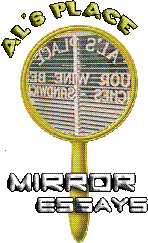
A Dissection of
|
The show "Quantum Leap" featured many controversial episodes, but one stands out from all the rest. This episode was called "Mirror Image" and was the finale to the cult hit TV series. Even now, nine years after its original airing, "Mirror Image" is still the most talked about episode of "Quantum Leap." This can most likely be attributed to the fact that pretty much *no one* understood it and have spent the last nine years trying to put the puzzle pieces together. As I watched this episode not long ago through reruns on cable TV, I found that I was beginning to think of it as a dream rather than a real "Leap." This was enforced when a friend made a reference to ruby slippers and the bartender telling Sam he can Leap himself home. The remark immediately fed the spark and became a fully ignited flame of an idea. I believe that the entity Leaping Sam felt that it was time to let Sam go home. However, GTFW (God/Time/Fate/Whatever) also knew that Sam must save Al's marriage. So, GTFW invoked a dream upon Sam after he Leaped out of Memphis. Through metaphors, symbols, and familiar people/names, GTFW gets the point across to Sam that he is Leaping himself around by not *truly* wanting to go home. And he does not truly want to go home because deep inside him, he knows that there is still a major wrong to put right for his best friend, Al Calavicci. Once Sam can accept that he has the power to return home, he will. The point of Sam's dream is to show him that "the rules"--which play a considerably large role in the series--really *don’t* count; that his desire to change things is what drives GTFW to keep him Leaping. It shows Sam that he *does* have the power to save Al's marriage, if only he'll forget about the rules and do what his heart tells him. This dream can be likened unto Dorothy Gale's dream in "Wizard of Oz". Sam sees people he recognizes, although they go by different names. I once read that things seen in a person’s dreams are usually triggered by something that he/she saw, heard, or did, the day before or recently. They can also be triggered by current or recent major events in either his/her life or in the world. This could be applied to Sam's dream. Most of the characters in the dream looked like people Sam had touched in previous Leaps. The names often were connected to Sam's life pre-Leaping. **Al the Bartender: His name was Al and he looked like Weird Ernie
from Sam's first Leap; he mentions that his brother was at Camp Edward [possible reference
to Edward AFB in "Genesis"?] (reference: "Genesis I & II") **Mutta: He looked like Jake Dorleac (reference: "Southern Comforts") **Mr. Collins: He looked like Don Geno (reference: "Double
Identity") The various familiar faces and names are simply there to give Sam a sense of familiarity in a strange Leap... which is a dream all along. Remember in "Wizard of Oz" that the Tinman, Scarecrow, Lion, Wizard, and Wicked Witch all looked like people Dorothy knew and cared about or had seen in the past day or so. The parallels in Sam's dream to "Wizard of Oz" start almost right away.
Like Glinda giving Dorothy hints about her own power, Al the
Bartender is guiding Sam through the dream by giving him questions that will invoke
thoughts of Leaping himself around. Then, much like Glinda telling Dorothy about the ruby
slippers, the Bartender tells Sam that he *can* go home. He just really, truly has to want
to. To veer away for a few moments, you must be wondering where the scenes with Gooshie and Al fit in. Well, what we see of the Project really is going on. Sam's body really did disappear. However, at the point that Al locks on to Sam, that's when reality splits into the dream. Al is really still doing a nanosecond search for Sam. But in the dream, Al appears to Sam, and tells him he's gonna get him out. It can be paralleled with the scene from "Wizard of Oz" when Dorothy looks into the crystal ball and sees Auntie Em crying for her... The part of the dream when Al tells Sam that he'll get him out of there is simply a reassurance to Sam that Al *is* trying to find him and *is* worrying about him. It's just a way to reassure the person dreaming that there IS someone out there worrying about them; someone out there who really cares.
This is where *most* similarities with "Wizard of Oz" end. Dorothy goes home... but Sam doesn't. Instead, Sam chooses not to go home so he can save Al and Beth's
marriage. GTFW is satisfied that Sam knows what he needs to know and realizes what good he
has done (parallel to Dorothy's realizations in the end that she really *is* cared for and
*has* done good for her family and friends), and so GTFW ends the dream and Leaps Sam into
Beth's house... because Sam has finally expressed his regret for not righting the wrong
and has expressed his longing to fix it. So, Sam actually physically Leaps straight from
Memphis to San Diego. There *was* no real Leap to Cokeburg. I stress the fact that we don't see Sam Leap because it can mean that he *did* Leap home from Beth's house. We just don’t know for sure. Or, if you want to go by the aired version, the "Dr. Becket never returned home" could have an add-on of "over the period of the next ten years" or "in a temporary situation like ‘The Leap Back’". We really don’t know. In conclusion, the parallels of "Mirror Image" to "Wizard of Oz" are uncanny and not in the least surprising. But no matter what I think, only Don Bellisario knows for sure how he will continue the Quantum Leap saga. And only Don Bellisario knows the *true* story behind the events in "Mirror Image". |
